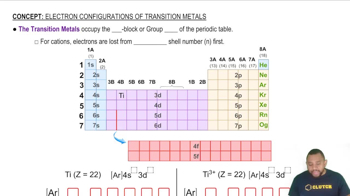The concept of chemical equilibrium is very important. Which one of the following statements is the most correct way to think about equilibrium? (a) If a system is at equilibrium, nothing is happening. (b) If a system is at equilibrium, the rate of the forward reaction is equal to the rate of the back reaction. (c) If a system is at equilibrium, the product concentration is changing over time.
Ch.4 - Reactions in Aqueous Solution
Chapter 4, Problem 7
The labels have fallen off three bottles containing powdered samples of metals; one contains zinc, one contains lead, and the other contains platinum. You have three solutions at your disposal: 1 M sodium nitrate, 1 M nitric acid, and 1 M nickel nitrate. How could you use these solutions to determine the identities of each metal powder?
 Verified step by step guidance
Verified step by step guidance1
Step 1: Understand the reactivity series of metals. Zinc is more reactive than nickel, lead is less reactive than nickel, and platinum is the least reactive of the three metals.
Step 2: Use 1 M nitric acid to test each metal. Nitric acid is a strong acid that can react with metals. Zinc will react vigorously with nitric acid, producing hydrogen gas and dissolving. Lead will react slowly, forming a protective layer of lead nitrate, while platinum will not react.
Step 3: Use 1 M nickel nitrate solution to test the remaining metals. Zinc, being more reactive than nickel, will displace nickel from nickel nitrate, forming zinc nitrate and nickel metal. Lead and platinum will not react with nickel nitrate as they are less reactive than nickel.
Step 4: Use 1 M sodium nitrate solution as a control. Sodium nitrate is a neutral salt and will not react with any of the metals, confirming that any observed reactions are due to the reactivity of the metals with the other solutions.
Step 5: Based on the reactions observed, identify the metals: the metal that reacts with nitric acid and nickel nitrate is zinc, the metal that reacts slowly with nitric acid is lead, and the metal that does not react with any solution is platinum.
Key Concepts
Here are the essential concepts you must grasp in order to answer the question correctly.
Reactivity of Metals
Different metals exhibit varying reactivities, which can be observed through their reactions with acids and other solutions. For instance, zinc is more reactive than lead and will readily react with acids to produce hydrogen gas, while platinum is much less reactive and does not react with dilute acids. Understanding these reactivity trends is essential for predicting how each metal will behave in the presence of the provided solutions.
Recommended video:
Guided course

Transition Metals
Acid-Base Reactions
Acid-base reactions involve the transfer of protons (H+) between reactants. In this context, nitric acid (a strong acid) can react with metals like zinc and lead, leading to the formation of metal nitrates and hydrogen gas. Recognizing how these reactions occur helps in identifying the metals based on their observable reactions with the acidic solution.
Recommended video:
Guided course

Acid-Base Reaction
Precipitation Reactions
Precipitation reactions occur when two soluble substances react to form an insoluble product, or precipitate. In this scenario, nickel nitrate can be used to test for the presence of lead, as lead(II) nitrate can precipitate when combined with certain anions. Understanding how to identify precipitates is crucial for distinguishing between the metals based on the reactions with the available solutions.
Recommended video:
Guided course

Selective Precipitation
Related Practice
Textbook Question
Textbook Question
You are presented with a white solid and told that due to careless labeling it is not clear if the substance is barium chloride, lead chloride, or zinc chloride. When you transfer the solid to a beaker and add water, the solid dissolves to give a clear solution. Next an Na2SO41aq2 solution is added and a white precipitate forms. What is the identity of the unknown white solid?
5
views
Textbook Question
Which of the following ions will always be a spectator ion in a precipitation reaction? (a) Cl- (b) NO3- (c) NH4+ (d) S2- (e) SO42-
1
views
Textbook Question
What kind of reaction is the 'water-splitting' reaction?H2O(l)¡H2(g) + ½ O2(g)(a) an acid-base reaction(b) a metathesis reaction(c) a redox reaction(d) a precipitation reaction
2
views
